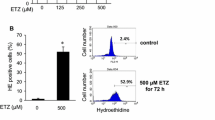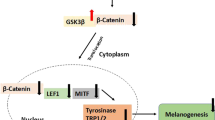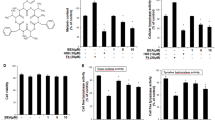Abstract
Acetylsalicylic acid (ASA) is widely used as an analgesic/antipyretic drug. It exhibits a wide range of biological effects, including preventative effects against heart attack and stroke, and the induction of apoptosis in various cancer cells. We previously found that ASA inhibits melanogenesis in B16 melanoma cells. However, the mechanisms of how ASA down-regulates melanin synthesis remain unclear. Here, we investigated the effect of ASA on melanogenic pathways, such as extracellular signal-regulated kinase (ERK) and microphthalmia-associated transcription factor (Mitf) transcription. ASA significantly inhibited melanin synthesis in a dose-dependent manner without oxidative stress and cell death. Semi-quantitative reverse transcription-polymerase chain reaction analysis showed that the inhibitory effect of ASA might be due to the inhibition of Mitf gene transcription. Interestingly, ASA also induced ERK phosphorylation. Additionally, treatment with PD98059, a specific ERK phosphorylation inhibitor, abolished the anti-melanogenic effect of ASA. These results suggest that the depigmenting effect of ASA results from down-regulation of Mitf, which is induced by both the induction of ERK phosphorylation and the inhibition of Mitf transcription.







Similar content being viewed by others
References
Hosomi Y, Yokose T, Hirose Y, Nakajima R, Nagai K, Nishiwaki Y, Ochiai A (2000) Increased cyclooxygenase 2 (COX-2) expression occurs frequently in precursor lesions of human adenocarcinoma of the lung. Lung Cancer 30:73–81
Qiao L, Hanif R, Sphicas E, Shiff SJ, Rigas B (1998) Effect of aspirin on induction of apoptosis in HT-29 human colon adenocarcinoma cells. Biochem Pharmacol 55:53–64
Rao CV, Reddy BS (2004) NSAIDs and chemoprevention. Curr Cancer Drug Targets 4:29–42
Wong BC, Zhu GH, Lam SK (1999) Aspirin induced apoptosis in gastric cancer cells. Biomed Pharmacother 53:315–318
Jana NR (2008) NSAIDs and apoptosis. Cell Mol Life Sci 65:1295–1301
Piazza GA, Rahm AK, Finn TS, Fryer BH, Li H, Stoumen AL, Pamukcu R, Ahnen DJ (1997) Apoptosis primarily accounts for the growth-inhibitory properties of sulindac metabolites and involves a mechanism that is independent of cyclooxygenase inhibition, cell cycle arrest, and p53 induction. Cancer Res 57:2452–2459
Bhattacharyya S, Ghosh S, Sil PC (2014) Amelioration of aspirin induced oxidative impairment and apoptotic cell death by a novel antioxidant protein molecule isolated from the herb Phyllanthus niruri. PLoS One 9:e89026
Born G, Patrono C (2006) Antiplatelet drugs. Br J Pharmacol 147(Suppl. 1):S241–S251
Butenas S, Cawthern KM, van’t Veer C, DiLorenzo ME, Lock JB, Mann KG (2001) Antiplatelet agents in tissue factor-induced blood coagulation. Blood 97:2314–2322
The Stroke Prevention in Atrial Fibrillation Investigators (1991) Stroke prevention in atrial fibrillation study. Final results. Circulation 84:527–539
Korner A, Pawelek J (1982) Mammalian tyrosinase catalyzes three reactions in the biosynthesis of melanin. Science 217:1163–1165
Hearing VJ, Tsukamoto K (1991) Enzymatic control of pigmentation in mammals. FASEB J 5:2902–2909
Matoba Y, Kumagai T, Yamamoto A, Yoshitsu H, Sugiyama M (2006) Crystallographic evidence that the dinuclear copper center of tyrosinase is flexible during catalysis. J Biol Chem 281:8981–8990
Decker H, Schweikardt T, Tuczek F (2006) The first crystal structure of tyrosinase: all questions answered? Angew Chem Int Ed 45:4546–4550
Aroca P, Solano F, Salinas C, Garcia-Borron JC, Lozano JA (1992) Regulation of the final phase of mammalian melanogenesis: the role of DOPAchrome tautomerase and the ratio between 5,6-dihydroxyindole-2-carboxylic acid and 5,6-dihydroxyindole. Eur J Biochem 208:155–163
Jackson IJ, Chambers DM, Tsukamoto K, Copeland NG, Gilbert DJ, Jenkins NA, Hearing VJ (1992) A second tyrosinase-related protein, TRP-2, maps to and is mutated at the mouse slaty locus. EMBO J 11:527–535
Kameyama K, Takemura T, Hamada Y, Sakai C, Kondoh S, Nishiyama S, Urabe K, Hearing VJ (1993) Pigment production in murine melanoma cells in regulated by tyrosinase-related protein-1 (TRP-1), DOPAchrome tautomerase (TRP-2), and a melanogenic inhibitor. J Investig Dermatol 100:126–131
Tsukamoto K, Jackson IJ, Urabe K, Montague PM, Hearing VJ (1992) A second tyrosinase-related protein, TRP-2, is a melanogenic enzyme termed DOPAchrome tautomerase. EMBO J 11:519–526
Romeo-Graillet C, Aberdam E, Biagoli N, Massabni W, Ortonne JP, Ballotti R (1996) Ultraviolet B radiation acts through the nitric oxide and cGMP signal transduction pathway to stimulate melanogenesis in human melanocytes. J Biol Chem 271:28052–28056
Park HY, Perez JM, Laursen R, Hara M, Gilchrest BA (1999) Protein kinase C-β activates tyrosinase by phosphorylating serine residues in its cytoplasmic domain. J Biol Chem 274:16470–16478
Steingrimsson E, Copeland NG, Jenkins NA (2004) Melanocytes and the microphthalmia transcription factor network. Annu Rev Genet 38:365–411
Bertolotto C, Abbe P, Hemesath TJ, Bille K, Fisher DE, Ortonne JP, Ballotti R (1998) Microphthalmia gene product as a signal transducer in cAMP-induced differentiation of melanocytes. J Cell Biol 142:827–835
Englaro W, Bertolotto C, Busca R, Brunet A, Pages G, Ortonne JP, Ballotti R (1998) Inhibition of the mitogen-activated protein kinase pathway triggers B16 melanoma cell differentiation. J Biol Chem 273:9966–9970
Xu W, Gong L, Haddad MM, Bischof O, Campisi J, Yeh ET, Medrano EE (2000) Regulation of Microphthalmia-associated transcription factor MITF protein levels by association with the ubiquitin-conjugating enzyme hUBC9. Exp Cell Res 255:135–143
Hemesath TJ, Price ER, Takemoto C, Badalian T, Fisher DE (1998) MAP kinase links the transcription factor microphthalmia to c-kit signaling in melanocyte. Nature 391:298–301
Sato K, Takahashi H, Iraha R, Toriyama M (2008) Down-regulation of tyrosinase expression by acetylsalicylic acid in murine B16 melanoma. Biol Pharm Bull 31:33–37
Sato K, Takahashi H, Toriyama M (2011) Depigmenting mechanism of NSAIDs on B16F1 melanoma cells. Arch Dermatol Res 303:171–180
Xia T, Korge P, Weiss JN, Li N, Venkatesen MI, Sioutas C, Nel A (2004) Quinones and aromatic chemical compounds in particulate matter induce mitochondrial dysfunction: implications for ultrafine particle toxicity. Environ Health Perspect 112:1347–1358
Sato K, Toriyama M (2009) Effect of pyrroloquinoline quinone (PQQ) on melanogenic protein expression in murine B16 melanoma. J Dermatol Sci 53:140–145
Sato K, Morita M, Ichikawa C, Takahashi H, Toriyama M (2008) Depigment mechanisms of all-trans retinoic acid and retinol on B16 melanoma cells. Biosci Biotechnol Biochem 72:2589–2597
Dikshit P, Chatterjee M, Goswami A, Mishra A, Jana NR (2006) Aspirin induces apoptosis through the inhibition of proteasome function. J Biol Chem 281:29228–29235
Guthrie HD, Welch GR (2006) Determination of intracellular reactive oxygen species and high mitochondrial membrane potential in percoll-treated viable boar sperm using fluorescence-activated flow cytometry. J Anim Sci 84:2089–2100
Tachibana M, Takeda K, Nobukuni Y, Urabe K, Long JE, Meyers KA, Aaronson SA, Miki T (1996) Ectopic expression of MITF, a gene for Waardenburg syndrome type 2, converts fibroblasts to cells with melanocyte characteristics. Nat Genet 14:50–54
Aksan I, Goding CR (1998) Targeting the microphthalmia basic helix-loop-helix-leucine zipper transcription factor to a subset of E-box elements in vitro and in vivo. Mol Cell Biol 18:6930–6938
Costin GE, Hearing VJ (2007) Human skin pigmentation: melanocytes modulate skin color in response to stress. FASEB J 21:976–994
Kim DS, Hwang ES, Lee JE, Kim SY, Kwon SB, Park KC (2003) Sphingosine-1-phosphate decreases melanin synthesis via sustained ERK activation and subsequent MITF degradation. J Cell Sci 116:1699–1706
Liu WS, Kuan YD, Chiu KH, Wang WK, Chang FH, Liu CH, Lee CH (2013) The extract of Rhodobacter sphaeroides inhibits melanogenesis through the MEK/ERK signaling pathway. Mar Drugs 11:1899–1908
Ashton M, Hanson PJ (2002) Disparate effects of non-steroidal anti-inflammatory drugs on apoptosis in guinea-pig gastric mucous cells: inhibition of basal apoptosis by diclofenac. Br J Pharmacol 135:407–416
Weissmann G (1991) Aspirin. Sci Am 264:84–90
Abdel-Malek Z, Scott MC, Suzuki I, Tada A, Im S, Lamoreux L, Ito S, Barsh G, Hearing VJ (2000) The melanocortin-1 receptor is a key regulator of human cutaneous pigmentation. Pigment Cell Res 13(Suppl. 8):156–162
Bertolotto C, Busca R, Abbe P, Bille K, Aberdam E, Ortonne JP, Ballotti R (1998) Different cis-acting elements are involved in the regulation of TRP1 and TRP2 promoter activities by cyclic AMP: pivotal role of M boxes (GTCATGTGCT) and of microphthalmia. Mol Cell Biol 18:694–702
Wu M, Hemesath TJ, Takemoto CM, Horstmann MA, Wells AG, Price ER, Fisher DZ, Fisher DE (2000) c-Kit triggers dual phosphorylations, which couple activation and degradation of the essential melanocyte factor Mi. Genes Dev 14:301–312
Kim ES, Jeon HB, Lim H, Shin JH, Park SJ, Jo YK, Oh W, Yang YS, Cho DH, Kim JY (2015) Conditioned media from human umbilical cord blood-derived mesenchymal stem cells inhibits melanogenesis by promoting proteasomal degradation of Mitf. PLoS One 10:e0128078
Rundhaug JE, Fischer SM (2008) Cyclo-oxygenase-2 plays a critical role in UV-induced skin carcinogenesis. Photochem Photobiol 84:322–329
Trifan OC, Hla T (2003) Cyclooxygenase-2 modulates cellular growth and promotes tumorigenesis. J Cell Mol Med 3:207–222
Smith WL, DeWitt DL, Garavito RM (2000) Cyclooxygenases: structural, cellular, and molecular biology. Annu Rev Biochem 69:145–182
Warner TD, Giuliano FG, Vojnovic I, Bukasa A, Mitchell JA, Vane JR (1999) Nonsteroid drug selectivities for cyclo-oxygenase-1 rather than cyclo-oxygenase-2 are associated with human gastrointestinal toxicity: a full in vitro analysis. Proc Natl Acad Sci USA 96:7563–7568
Kim JY, Shin JY, Kim MR, Hann S-K, Oh SH (2012) siRNA-mediated knock-down of COX-2 in melanocytes suppress melanogenesis. Exp Dermatol 21:420–425
Acknowledgments
This work was supported by Japan Society for the Promotion of Science KAKENHI Grant Number 25740018.
Author contributions
T.N. and K.S. designed the experiments; T.N., M.U., M.A., S.S., and K.S. performed the experiments; T.N. and K.S. analyzed the data. K.S. wrote this paper.
Author information
Authors and Affiliations
Corresponding author
Rights and permissions
About this article
Cite this article
Nishio, T., Usami, M., Awaji, M. et al. Dual effects of acetylsalicylic acid on ERK signaling and Mitf transcription lead to inhibition of melanogenesis. Mol Cell Biochem 412, 101–110 (2016). https://doi.org/10.1007/s11010-015-2613-x
Received:
Accepted:
Published:
Issue Date:
DOI: https://doi.org/10.1007/s11010-015-2613-x




